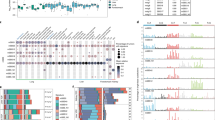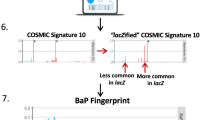Abstract
MICROBIAL1, mammalian2,3 and human4,5 bioassays are being applied to uncover the mutagenic action of synthetic compounds which have been introduced accidently or intentionally into the environment. Somewhat less attention has been given to the potential genetic hazard of chemicals which are an essential part of human nutrition or are formed within mammalian tissues and organs. Ascorbic acid belongs to this group of “neglected” naturally occurring compounds, although its capacity to form radicals and its interaction with viral6 and bacterial7 DNA should have raised suspicion about its possible mutagenic capacity. Considering the large daily intake of ascorbic acid, its addition to many food products8 and its potential use as an inhibitor of the intragastric formation of N-nitroso compounds8,9 and nitrosamine formation in food products10, its action on the genome of human cells requires investigation. We here present evidence, from several experimental systems, suggesting that vitamin C, particularly in the presence of copper, has a mutagenic effect.
This is a preview of subscription content, access via your institution
Access options
Subscribe to this journal
Receive 51 print issues and online access
$199.00 per year
only $3.90 per issue
Buy this article
- Purchase on Springer Link
- Instant access to full article PDF
Prices may be subject to local taxes which are calculated during checkout
Similar content being viewed by others
References
Ames, B. N., Durston, W. E., Yamasaka, E., and Lee, F. D., Proc. natn. Acad. Sci. U.S.A., 70, 2281–2283 (1973).
Epstein, S. S., Arnold, E., Andrea, J., Bass, W., and Bishop, Y., Toxic. appl. Pharmac., 23, 288–325 (1972).
Wyrobek, A. J., and Bruce, W. R., Proc. natn. Acad. Sci. U.S.A. (in the press).
Stich, H. F., Kieser, D., Laishes, B. A., and San, R. H. C., Proc. tenth Can. Cancer Conf., 83–110, (University of Toronto Press, Toronto, 1973).
San, R. H. C., and Stich, H. F., Int. J. Cancer, 16, 284–291 (1975).
Bode, V. C., J. molec. Biol., 26, 125–129 (1967).
McCarty, M., J. exp. Med., 81, 507–514 (1945).
Vitamin C (edit. by Birch, G. B., and Parker, Y. T.) (Applied Sciences Publishers, London, 1974).
Mirvish, S. S., Wallcave, L., Eagen, M., and Shubik, P., Science, 177, 65–68 (1972).
Fiddler, W., Pensabene, J. W., Piotrowski, E. G., Doerr, R. C., and Wasserman, A. E., J. Fd Sci., 38, 1084 (1973).
Laishes, B. A., and Stich, H. F., Biochem. biophys. Res. Commun., 52, 827–833 (1973).
Stich, H. F., and San, R. H. C., Mutat. Res., 10, 389–404 (1970).
Stich, H. F., Stich, W., and San, R. H. C., Proc. Soc. exp. Biol. Med., 142, 1141–1144 (1973).
Stich, H. F., San, R. H. C., Miller, J. A., and Miller, E. C., Nature new Biol., 238, 9–10 (1972).
Nishioka, H., Mutat. Res., 31, 185–189 (1975).
Wong, K., Morgan, A. R., and Paranchyk, W., Can. J. Biochem., 52, 950–958 (1974).
Yamafuji, K., Nakamura, Y., Omura, H., Soeda, T., and Gytoku, K., Z. Krebsforsch., 76, 1–7 (1971).
Author information
Authors and Affiliations
Rights and permissions
About this article
Cite this article
STICK, H., KARIM, J., KOROPATNICK, J. et al. Mutagaenic action of ascorbic acid. Nature 260, 722–724 (1976). https://doi.org/10.1038/260722a0
Received:
Accepted:
Issue Date:
DOI: https://doi.org/10.1038/260722a0
This article is cited by
-
In vitro toxicological evaluation of arsenic on superoxide dismutase mediated oxidative stress in renal cells of rat and its amelioration with supplementation of Pleurotus florida lectin (PFL)
Comparative Clinical Pathology (2021)
-
NO-System und Antioxidanzien
HNO (2009)
-
Ascorbate on cell growth and differentiation
Journal of Bioenergetics and Biomembranes (1994)
-
Malignant disease: nutritional implications of disease and treatment
Cancer and Metastasis Review (1987)
Comments
By submitting a comment you agree to abide by our Terms and Community Guidelines. If you find something abusive or that does not comply with our terms or guidelines please flag it as inappropriate.



